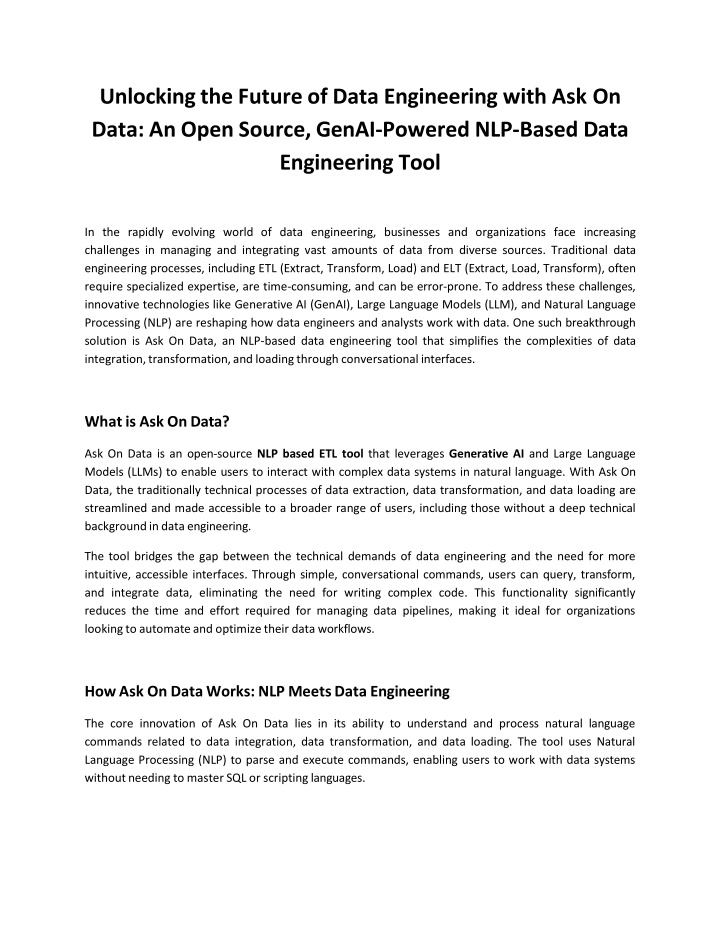Ask On Data
Ask On Data, an NLP based data engineering tool that simplifies the complexities of data integration, transformation, and loading through conversational interfaces.
Download Presentation

Please find below an Image/Link to download the presentation.
The content on the website is provided AS IS for your information and personal use only. It may not be sold, licensed, or shared on other websites without obtaining consent from the author.If you encounter any issues during the download, it is possible that the publisher has removed the file from their server.
You are allowed to download the files provided on this website for personal or commercial use, subject to the condition that they are used lawfully. All files are the property of their respective owners.
The content on the website is provided AS IS for your information and personal use only. It may not be sold, licensed, or shared on other websites without obtaining consent from the author.
E N D
Presentation Transcript
Unlocking the Future of Data Engineering with Ask On Data: An Open Source, GenAI-Powered NLP-Based Data Engineering Tool In the rapidly evolving world of data engineering, businesses and organizations face increasing challenges in managing and integrating vast amounts of data from diverse sources. Traditional data engineering processes, including ETL (Extract, Transform, Load) and ELT (Extract, Load, Transform), often require specialized expertise, are time-consuming, and can be error-prone. To address these challenges, innovative technologies like Generative AI (GenAI), Large Language Models (LLM), and Natural Language Processing (NLP) are reshaping how data engineers and analysts work with data. One such breakthrough solution is Ask On Data, an NLP-based data engineering tool that simplifies the complexities of data integration, transformation, and loading through conversational interfaces. What is Ask On Data? Ask On Data is an open-source NLP based ETL tool that leverages Generative AI and Large Language Models (LLMs) to enable users to interact with complex data systems in natural language. With Ask On Data, the traditionally technical processes of data extraction, data transformation, and data loading are streamlined and made accessible to a broader range of users, including those without a deep technical background in data engineering. The tool bridges the gap between the technical demands of data engineering and the need for more intuitive, accessible interfaces. Through simple, conversational commands, users can query, transform, and integrate data, eliminating the need for writing complex code. This functionality significantly reduces the time and effort required for managing data pipelines, making it ideal for organizations looking to automate and optimize their data workflows. How Ask On Data Works: NLP Meets Data Engineering The core innovation of Ask On Data lies in its ability to understand and process natural language commands related to data integration, data transformation, and data loading. The tool uses Natural Language Processing (NLP) to parse and execute commands, enabling users to work with data systems without needing to master SQL or scripting languages.
Data Integration: Ask On Data connects seamlessly with various data sources, whether its a data lake, data warehouse, or cloud-based data storage system. Users can simply input commands like, Integrate data from my sales database with customer feedback from the cloud, and Ask On Data will manage the connection, data extraction, and integration processes. Data Transformation: Data transformation is another area where Ask On Data excels. Users can request transformations in natural language, such as Convert all dates in this dataset to ISO format or Aggregate sales data by region for the last quarter, and the tool will apply the transformations without needing complex scripts. Data Loading: Once data is transformed, Ask On Data can automatically load it into the target system, whether it s a data warehouse for analytics or a data lake for storage. Users can issue simple commands to initiate loading, such as Load transformed data into the reporting database. Benefits of Ask On Data in Data Engineering Simplified Data Operations: By using natural language to manage ETL/ELT processes, Ask On Data lowers the barrier for non-technical users to access and manipulate data. This democratization of data engineering allows business analysts, data scientists, and even executives to interact with data more easily. Increased Efficiency: Automation of routine data tasks, like data extraction, transformation, and loading, speeds up the process and reduces human errors. With GenAI at its core, Ask On Data can also generate code or queries based on user instructions, making it a powerful assistant for data engineers. Open-Source Flexibility: Ask On Data is an open-source tool, meaning it is freely available and highly customizable. Organizations can adapt the tool to fit their specific needs, from integrating it into custom workflows to extending its capabilities through plugins or custom scripts. Improved Collaboration: With its intuitive, chat-based interface, Ask On Data fosters better collaboration across teams. Data engineers can focus on more complex tasks while empowering other stakeholders to interact with data without fear of making mistakes or having to understand complex technologies. The Future of Data Engineering with NLP and GenAI The integration of Generative AI and LLMs into data engineering tools like Ask On Data represents a paradigm shift in how data operations are managed. By combining the power of AI with the simplicity of NLP, Ask On Data enables organizations to make smarter, faster decisions and streamline their data workflows.
As businesses continue to generate more data and migrate towards cloud-based solutions, tools like Ask On Data will become increasingly important in helping them integrate, transform, and analyze data efficiently. By making ETL and ELT processes more accessible and intuitive, Ask On Data is laying the groundwork for the future of data transformation, data loading, and data integration. Conclusion, Ask On Data is an innovative NLP-based data engineering tool that empowers users to manage complex data workflows with ease. Whether you're working with a data lake, a data warehouse, or cloud-based platforms, Ask On Data s conversational interface simplifies the tasks of data transformation, data integration, and data loading, making it a must-have tool for modern data engineering teams.























